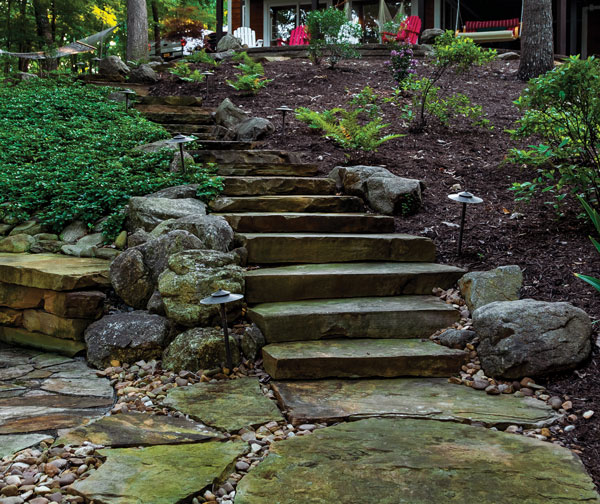
The pathways around your home aren’t just about getting from one point to another. They can and should be a beautiful part of your property’s design. But with all the options out there, it can be hard to decide exactly what the best choice for your home and lifestyle is. We talked to local experts to get their advice on creating steps and pathways that are safe, durable, and—of course— attractive.
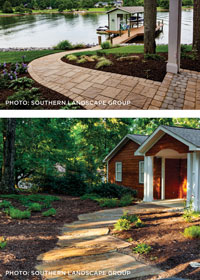 Make a plan
Make a plan
Before beginning any landscape project, set aside time to talk with your designer. Their experience is invaluable for making the right decisions for your property, style, and budget.
“I personally spend a lot of my time in the planning and designing phase of the project,” says Mark Maslow, owner and president of Southern Landscape Group. “Often we get clients asking for a certain feature or material. After better understanding the intended use, sometimes we find… what they want is not the best solution.”
Chris Templeton, president of local landscape design firm CLC Inc., says that in addition to the aesthetics, safety and cost are the major elements driving many decisions when it comes to pathways and steps around lake properties. “The main challenge is trying to figure out a way for people to safely get from their house, which is often very elevated, down to the water level.”
But, he adds, it’s also important to consider how you want to use your property so you don’t find yourself redoing costly design decisions. If, for example, you might later add a pool or a space for children to play, let your designer know so they can lay out pathways with those elements in mind.
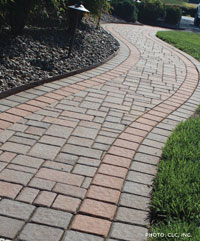 Understand the cost
Understand the cost
No matter what your overall budget is, it’s important to understand the costs of the individual elements you choose.
Your designer should be able to suggest multiple options to achieve your preferred look at different price points. They can also help you find less expensive sources for materials, says Maslow, who recommends looking for deals from local stone yards that are trying to liquidate extra stock.
You also need to consider the cost of maintaining or replacing your walkways in the future. “Depending on the type of pathway, you may expect some maintenance from it,” cautions Maslow.
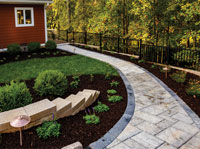 A pathway made of pavers, for example, may have a higher upfront cost, but will need minimal maintenance aside from powerwashing every few years. Wood, by contrast, is a choice Maslow is glad to see fading from popularity, because homeowners have realized it’s a poor investment. “Wood rots, it gives you splinters, and it requires a lot of maintenance,” says Maslow. “While inexpensive to install initially, the maintenance costs can be overwhelming.”
A pathway made of pavers, for example, may have a higher upfront cost, but will need minimal maintenance aside from powerwashing every few years. Wood, by contrast, is a choice Maslow is glad to see fading from popularity, because homeowners have realized it’s a poor investment. “Wood rots, it gives you splinters, and it requires a lot of maintenance,” says Maslow. “While inexpensive to install initially, the maintenance costs can be overwhelming.”
Keep your family safe
No matter your age and physical ability, it’s important to create paths that allow you to move safely. Sloped paths are harder to walk down than steps, and narrow pathways can be awkward for more than one person at a time. To make the best use of your property, Maslow recommends keeping pathways at least 54 inches wide and using a combination of flat paths and stairs.
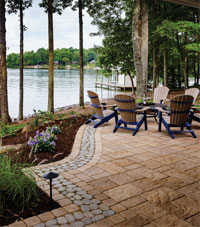 Another important safety factor, and one that many homeowners overlook, is good lighting. If you install outdoor lighting next to all your pathways, especially on slopes or by steps, you’ll be able to use your property at any time of the day or night.
Another important safety factor, and one that many homeowners overlook, is good lighting. If you install outdoor lighting next to all your pathways, especially on slopes or by steps, you’ll be able to use your property at any time of the day or night.
Choose materials
Many factors go into choosing materials for steps and pathways, including style, durability, safety, and cost.
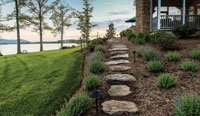 Natural stone: Natural stone can be expensive, but it is one of the most beautiful and popular choices around the lake. You can make whole paths and stairs out of natural stone, or sink individual stepping stones into grass to create a less expensive— but still beautiful—walkway. It is durable, safe to walk on, and requires almost no maintenance.
Natural stone: Natural stone can be expensive, but it is one of the most beautiful and popular choices around the lake. You can make whole paths and stairs out of natural stone, or sink individual stepping stones into grass to create a less expensive— but still beautiful—walkway. It is durable, safe to walk on, and requires almost no maintenance.
Travertine: A type of natural limestone, travertine is a favorite for pavers and steps that don’t get hot under bare feet in the summer. Travertine comes in a variety of earth-tone colors and holds up well on slopes. It is a mid-range option for pathways, requires little maintenance, and is unlikely to break over time because it flexes with the ground.
Grass pavers: Made of a honeycomb base planted with grass, these pavers are a good option for flat surfaces that get heavy traffic. They are inexpensive and create a beautiful, natural look. However, they can be dangerous on slopes, especially after rain or early in the morning, when the wet grass makes it easy to slip.
Gravel: Gravel is a budget-friendly option for pathways around your lake home and can cover a large area of ground for very little cost. However, it can make for treacherous paths on hills and is often unsafe for older visitors who have a hard time moving without assistance. Gravel in sloped pathways can be washed away by heavy rain and needs to be replaced regularly.
Wood: Wood has a low up-front cost for stairs and pathways around the lake; however, wood walkways need to be replaced every few years, as they can splinter and rot. Wood steps and rails last longer but still need to be replaced periodically to stay safe.
Concrete: Concrete pathways and steps are durable on slopes, and concrete paths are a budget-friendly option if you are planning to use a golf cart to get down to the lake. Since concrete doesn’t flex with the ground, it will eventually crack and need to be replaced. Depending on the slope of your property, bringing in the equipment to pour concrete may be difficult. Stamped concrete pavers mimic the look of natural stone for much less, but require upkeep and resealing.
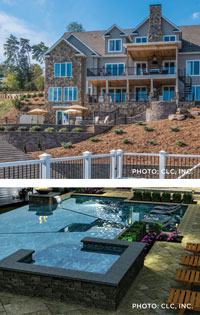 Plan for retirement
Plan for retirement
One change that both designers are noticing around the lake is a different kind of planning for the future.
“Today, we are seeing a need to plan for our clients to age at their lake home,” explains Maslow. “In the past we may have just installed a nice stone step path… Now, we are seeing clients who plan to retire in their lake home and want a smoother and more gentle access to the dock.”
If you hope to retire by the lake, ask your designer to make paths wide enough to accommodate a golf cart or to create a path that meanders down the slope rather than building stairs. It’s also smart to revisit your design and make small, regular changes, says Templeton. “Five years is typically how often we recommend looking at the overall plan,” he explains. “We can design it now, but we may have to tweak it because your physical ability may change, or you may have kids or grandkids visiting.”
One of the main draws of living in this beautiful area is, after all, to enjoy it. The right pathways and steps will allow you and your family to make the most out of your property for years to come. ✦
